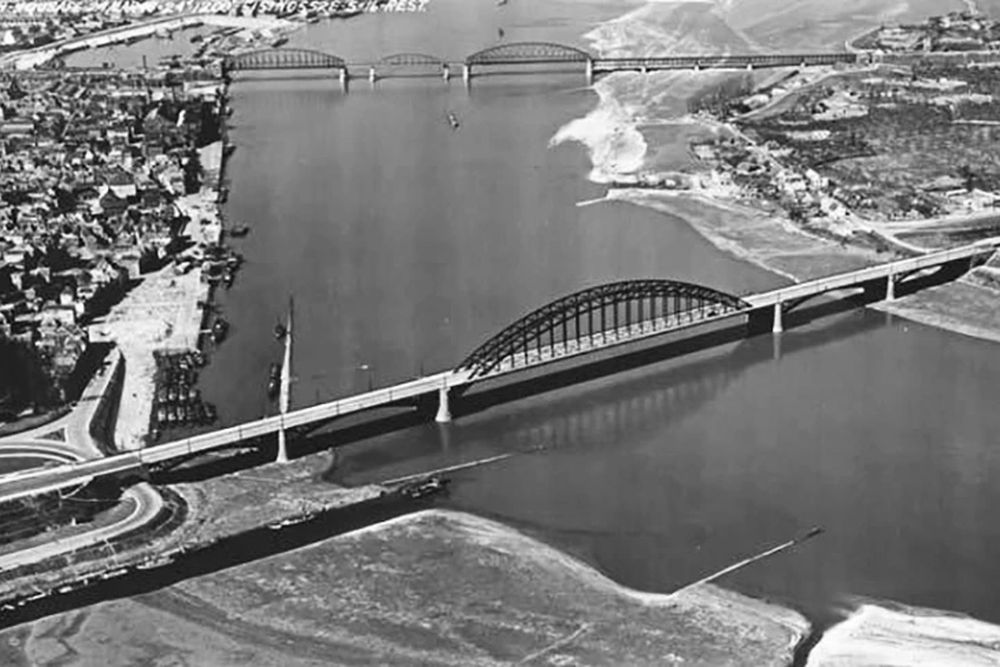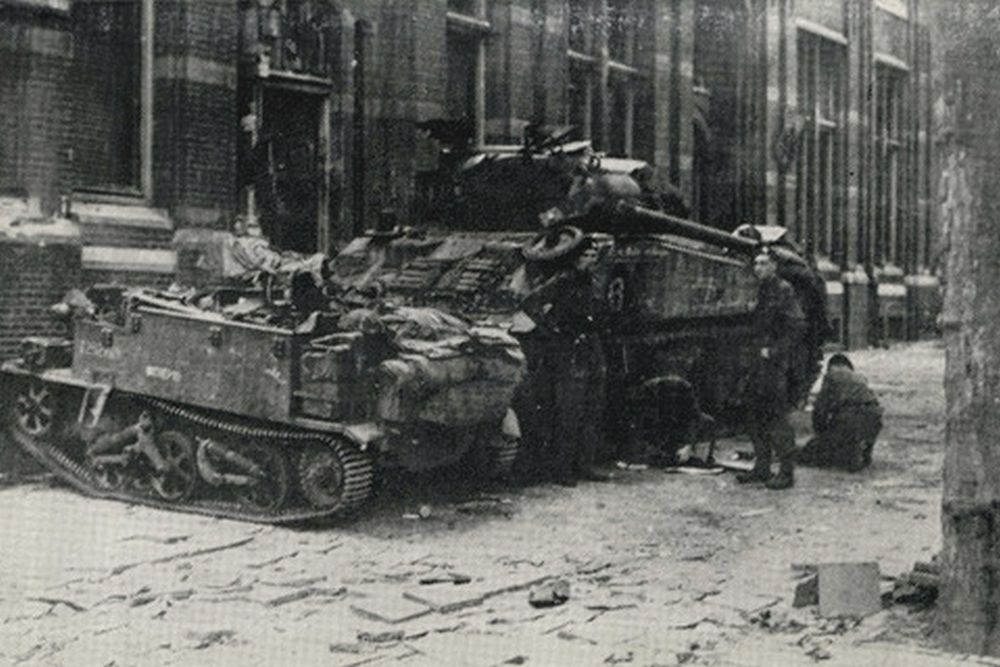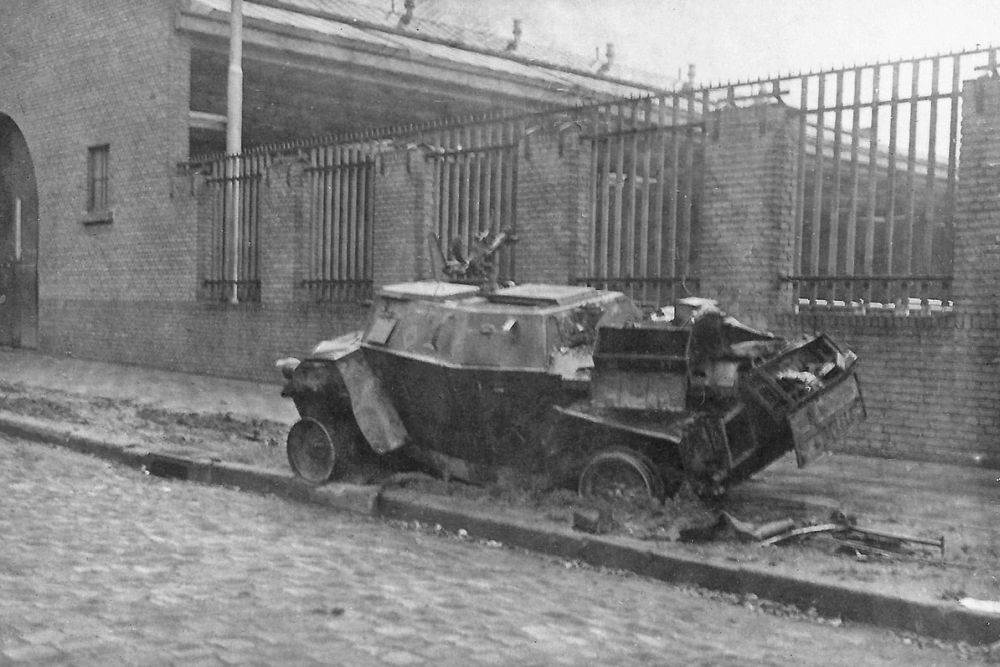Introduction
During Operation Market Garden the American 82nd Airborne Division landed near Nijmegen with the objective to capture a few bridges in and around Nijmegen among other things. Two of the most important were the road and the railway bridge across the river Waal. After the first attack on the road bridge had failed on September 17 and the second on September 18 as well, new plans were made to make another attempt supported by the onrushing British ground forces. When on September 19, British troops of XXX Corps finally flooded into Nijmegen, it was decided almost immediately to launch a joint attack by the British Guards Armoured Division and the 82nd Airborne Division on both bridges.
Preparations
One of the strategic goals of Market Garden was XXX Corps making its way over land to Arnhem as fast as possible. It was to cross several bridges which would had been captured previously by American paratroops. On September 19 at 08:20, the first armored vehicles of B Squadron, 2nd Household Cavalry Regiment reached the bridge near Grave. This bridge had been captured undamaged on September 17 by E Company, 504th PIR. The first tanks of the Grenadier Guards Group followed towards 10:00. This spearhead advanced via Overasselt and Heumen to Malden and Nijmegen, crossing the Maas-Waal canal on the way, where the vehicles assembled at Sionshof on the Groesbeekseweg via Heumensoord.[1][2][3].
The leaders of the operations around Nijmegen - Lieutenant-general Frederick Browning of I Airborne Corps, Brigadier-general James Gavin of 82nd Airborne Division, Lieutenant-general Brian Horrocks of XXX Corps/Guards Division and Major-general Allan Adair of XXX Corps/Guards Division - met in the morning of September 19 in Molenhoek in order to discuss the strategy to be followed for the progress of the battle.
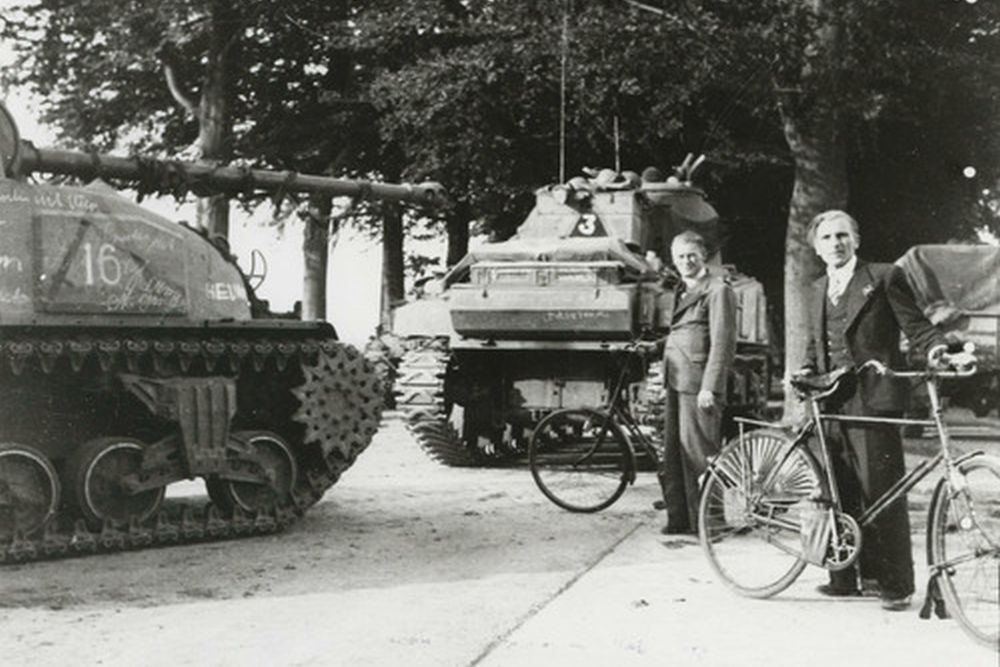
Grenadier Guards Group on the corner of hoek Rijksweg-Sint Annastraat on their way to the assembly point at the Sionshof, September 19, 1944 Source: Public Domain (unknown)
Major-general Allan Adair decided his entire Grenadiers Guards Group be deployed along with 2nd Battalion, 505th PIR of Lieutenant-colonel Benjamin Vandervoort to launch an attack on both bridges near Nijmegen. Lieutenant-colonel Edward H. Goulburn split the 40 tanks at his disposal in two groups: one for the road bridge and the other for the railway bridge. In the meantime, the scout unit of the Grenadier Guards Group, the 2nd Household Cavalry Regiment would open fire on the German artillery on the Lent side of the Waal. As soon as the division artillery of the Grenadier Guards had taken up their position, they would take over this task.[4][5]
The attack would be launched by three columns: Column A to attack the road bridge, (Commanding Officer Lieutenant-colonel Vandervoort-Benjamin-Hayes.htm">Benjamin H. Vandervoort of 505th PIR, Column B the railway bridge, (CO Captain John Warwick Neville of the Grenadier Guards) and Column C the area between A and B with as its prime target the main post office (CO Major George Thorne of the Grenadier Guards. Columns A and C initially formed one Eastern Force with 3 troops of tanks of No. 3 Squadron, 2nd Battalion, Grenadier Guards, supported by three platoons of infantry of No. 2 Company, 1st Battalion Grenadier Guards and E and F Company of the 2nd Battalion, 505th PIR. This Eastern Force was to capture the road bridge and the neighboring city center of Nijmegen. The Western Force, target the railway bridge, consisted of 1 troop of tanks of No. 3 Squadron, 2nd Battalion, Grenadier Guards, supported by 1 platoon of infantry of No. 2 Company, 1st Battalion, Grenadier Guards and D Company, 2nd Battalion, 505th PIR.[6][7][8]
Captain Harry Bestebreurtje, CO of a Jedbug Team Liaison Unit between the 82nd Airborne and the resistance in Nijmegen, was added to the G2 Section of the 82nd Airborne. On September 19, he had settled in hotel Sionshof in the Heilige Landstichting and he selected 4 guides to accompany the columns through Nijmegen. These were Adriaan Slob (Grenadier Guards), Harmen van de Pol, Piet Gerrits and Henk van Berne.[9][10]
The joint attack of the two Forces - or three columns - was launched at 15:15 from the vicinity of hotel-restaurant Sionshof where the troops had assembled.[11]
Definitielijst
- Cavalry
- Originally the designation for mounted troops. During World War 2 the term was used for armoured units. Main tasks are reconnaissance, attack and support of infantry.
- infantry
- Foot soldiers of a given army.
- Regiment
- Part of a division. A division divided into a number of regiments. In the army traditionally the name of the major organised unit of one type of weapon.
- resistance
- Resistance against the enemy. Often also with armed resources.
- Squadron
- A military unit in the Belgian navy usually six to eight small ships operating together under one command. The smallest military unit in the Dutch air force of about 350 men. In most countries is the designation of a military unit thesize of a company. It is either an independent unit, such as a battery, or part of a bigger Calvary unit. In the air force it is the designation of a unit of aircrafts.
- strategy
- Art of warfare, the way in which war should be conducted in general.
German defense
At about noon on September 19, the two bridges across the Waal were still firmly in Germans hands. The road bridge was defended by for instance a part of SS-Panzeraufklärungs-Abteilung 9, 1. Kompanie SS-Panzer-Pionier-Abteilung 10 (SS-Untersturmführer Werner Baumgärtel) and I. Bataillon, SS-Panzergrenadier-Regiment 21 (SS-Hauptsturmführer Karl-Heinz Euling). These units were under overall command of Karl-Heinz Euling and was named Kampfgruppe Euling. He set up his HQ in the Belvedere tower. The Hunnerpark and some fortifications around his HQ had been turned into a fortress with gun mounts, machinegun posts and trenches. Supporting fire was provided by the 4. Batterie, schwere Flak-Abteilung 572 with four 88mm and eight 20mm anti-aircraft guns. Reinforcement was provided by the Herrmann Göring Ausbildungs-Regiment which had taken up position in villa Belvoir.[12][13]The area between the two bridges was defended by Kampfgruppe Melitz, commanded by Major Engelbert Melitz and was made up of guards and police units.[14]
Kampfgruppe Henke, commanded by Oberst Friedrich (Fritz) Henke with his Fallschirmjäger-Lehrstab 1 defended Kronenburgerpark, the railway bridge and the Nijmegen shunting yard. In addition, this Kampfgruppe was made up of 29. Unteroffizier-Ausbildungs-Kompanie, parts of the Ersatz-Fallschirmjäger-Regiment Herrmann Göring, three companies of the Ersatz und Ausbildungs-Bataillon 6, parts of the 406. Landesschützen-Division and a few units of the Pionier-Kompanie 434, in total a force of some 500 men.[15][16]
All told, the area around the two bridges was defended by a force of some 2,000 men. The German defenders could rely on fire support from the 21. schwere-Batterie, V. Abteilung, SS-Artillerie-Ausbildungs-und-Ersatz-Regiment in position near Oosterhout and the 19. Batterie of the same unit which had taken up position near Ressen. In order to keep the lines short, the Befehlsstelle, commanded by SS-Hauptsturmführer Oskar Schwappacher of these two batteries had settled in Lent. On September 19, the SS-Panzer-Pionier-Abteilung 10 managed to construct a ferry near Pannerden which was able to get heavy tanks across the river. In the evening of the 19th, this ferry was operational but it was too late to get the tanks in Nijmegen on time.[17][18][19][20]
Definitielijst
- Abteilung
- Usually part of a Regiment and consisting of several companies. The smallest unit that could operate independently and maintain itself. In theory an Abteilung comprised 500-1,000 men.
- Fallschirmjäger
- German paratroopers. Part of the Luftwaffe.
- Flak
- Flieger-/Flugabwehrkanone. German anti-aircraft guns.
- Kampfgruppe
- Temporary military formation in the German army, composed of various units such as armoured division, infantry, artillery, anti-tank units and sometimes engineers, with a special assignment on the battlefield. These Kampfgruppen were usually named after the commander.
- Regiment
- Part of a division. A division divided into a number of regiments. In the army traditionally the name of the major organised unit of one type of weapon.
The attack: Column A
Columns A and C of the Eastern Force and Column B of the Western Force left Sionshof at about 14:45 by way of Groesbeekseweg in the direction of the Waal bridge. At Groesbeeksedwarsweg Column A separated from the group, Column B continued in the direction of the railway bridge and Column C to the old post office.[21][22]
Column A consisted of 400 men of E Company (Lieutenant James J. Smith) and F Company of the 2nd Battalion, 505th PIR, supported by three troops of Sherman tanks, 12 in total, of 2nd Battalion, Grenadier Guards. The column was guided by Adriaan Slob and was under command of Lieutenant-colonel Benjamin Vandervoort.[23][24]
The American paratroops got involved in heavy street fighting almost immediately and progress often had to be made through gardens and over roofs. These claimed a considerable number of casualties such as squad leaders Thomas Burke, Richard Crouse and Ben Popilski. During heavy fighting around Mariaplein, the Wilhelmina hospital on Dr Claes Noordduijnstraat and on Graadt van Roggenstraat the vulnerability of the Sherman tanks in street fighting became obvious. Four vehicles belonging to the group of Lieutenant John Mollers were knocked out by German anti-tank fire.[25][26]

American paratroops crossing Mariaplein during the attack on September 19 Source: Public Domain (unknown)
F Company of Captain Hubert F. Bass advanced by a more southerly route with a number of British tanks to Hunnerpark but was soon stopped in its tracks by a road block. E Company of 1st Lieutenant James J. Smith advanced on the right flank along with British infantry and the rest of the tanks. They too were stopped by heavy defensive fire.[27]
In the end, the paratroops managed to reach the block of buildings on Sint Canisiussingel, through gardens and sometimes straight through walls of houses. The infantry of No. 2 Company, 1st Battalion Grenadier Guards attempted to bypass the Germans on the flanks but ran into the defenses around Keizer Lodewijkplein as well. At that moment, the tanks couldn't go on as a 88mm gun had managed to seal off the entrances (Sint Jorisstraat, Sint Canisiussingel, Mr Franckenstraat and Barbarossastraat) to the square. German troops had turned the ruins of villa Belvoir into a fortress and had established a defensive belt near the Ubbergseweg on the southern ramp of the road bridge. In support of the German defense, four tanks took up positions near the southern ramp of the road bridge.[28][29][30]
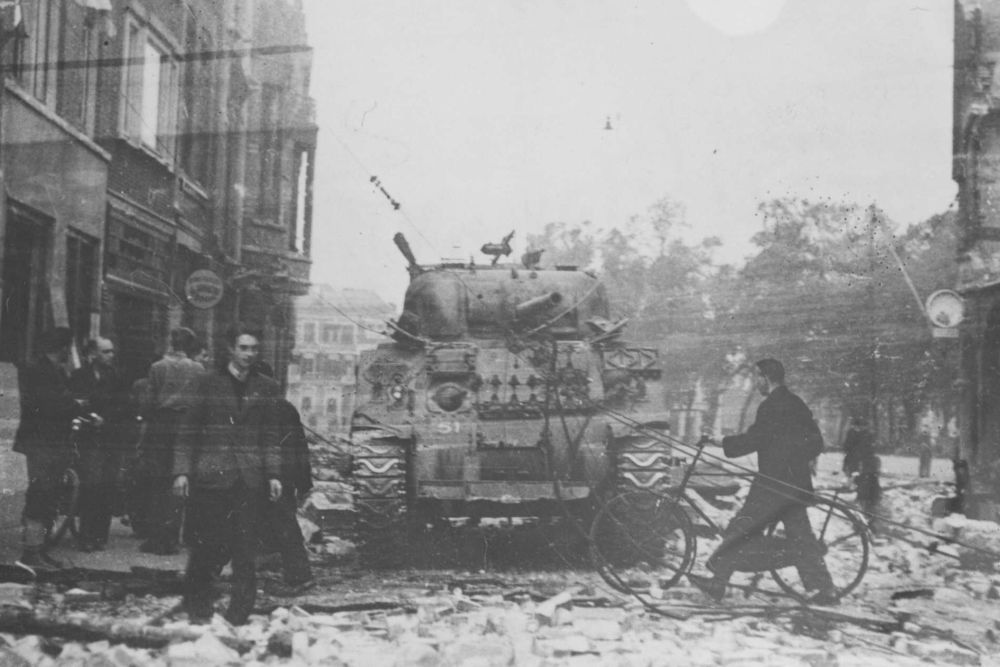
On St. Jorisstraat a disabled Sherman tank, September 21, 1944 Source: Fotocollectie Regionaal Archief Nijmegen F14467
In the early evening, at 18:45, Benjamin Vandervoort could report his troops stood poised to capture Hunnerpark at some 400 yards from the ramp of the road bridge and to send the British tanks onto the bridge in order to establish a bridgehead in Lent. However, he was ordered to hold his position in order to resume the attack the next day, September 20. Although Column A certainly had made progress. the other columns had been brought to a halt.[31][32]
Definitielijst
- infantry
- Foot soldiers of a given army.
The attack: Column B
Column B, target the railway bridge, was made up of two platoons infantry of the 2nd Battalion Grenadier Guards and D Company, 505th PIR (1st Lieutenant Oliver B. Carr). They were supported by five Sherman tanks of 3rd Squadron, 2nd Battalion Grenadier Guards commanded by Lieutenant James Scott and five armored vehicles. Support was provided by the infantry of 2nd Company, 1st Motorized Battalion, Grenadier Guards. The column was commanded by Captain J. Neville of the Grenadier Guards, with Herman van de Pol (possibly Piet Gerrits as well) as added guide.[33][34][35]
The column advanced on the railway bridge via Wezenlaan, Groenestraat, Graafseweg, Nieuwe Nonnendaalseweg and Koninginnelaan. It approached the bridge via Oude Heselaan. At about 16:00 it moved along the western side of the railway embankment in the direction of the bridge. The main body with the tanks attempted to reach the bridge via Hezelpoort. One company managed to reach Kronenburgerpark via the shunting yard. Here as well, the men had to advance through gardens, across roofs and sometimes straight through walls. The Germans had established a strong defensive line with Kampfgruppe Runge along Kronenburgerpark, Hezelpoort, the bank of the Waal and the ramp to the bridge. A former 45mm Soviet anti-tank gun and two 20mm rapid fire guns knocked out two Sherman tanks at 500 yards from the ramp. 1st Lieutenant Waverly W. Wray van D Company, 505th PIR was killed by a German sniper. For his role in the battle, he would be decorated posthumously with the Militaire Willems Orde 4. Due to a shortage of ammunition, Captain Neville was compelled to withdraw his column and established a defensive line around the church on Krayenhoflaan.[36][37][38][39]
Definitielijst
- infantry
- Foot soldiers of a given army.
- Kampfgruppe
- Temporary military formation in the German army, composed of various units such as armoured division, infantry, artillery, anti-tank units and sometimes engineers, with a special assignment on the battlefield. These Kampfgruppen were usually named after the commander.
- sniper
- Military sniper who can eliminate individual targets at long distances (up to about 800 meters).
- Squadron
- A military unit in the Belgian navy usually six to eight small ships operating together under one command. The smallest military unit in the Dutch air force of about 350 men. In most countries is the designation of a military unit thesize of a company. It is either an independent unit, such as a battery, or part of a bigger Calvary unit. In the air force it is the designation of a unit of aircrafts.
The attack: Column C
The third column, C had the main post office on Van Schevichavenstraat as its main target as it was assumed the detonation mechanism to blow the road bridge was located there. The column, commanded by Major George Thorne of the Grenadier Guards was escorted by guide Henk van Berne and was made up of No. 3 Company, 1st Grenadier Guards and a platoon of the 505th PIR, supported by four Sherman tanks from No. 1 Squadron, 2nd Grenadier Guards.[40][41] By way of Groesbeekseweg, Coehoornstraat, Van Gentstraat, Prins Bernhardstraat and Oranjesingel, the main post office on Van Schevichavenstraat was reached. At Prins Bernhardstraat, a German anti-tank gun was knocked out.[42]
Member of the resistance, Jan van Hoof, who hadn't come along initially despite a request from Bestebreurtje, eventually decided to come along with the attack of this unit anyway after being asked by the crew of Humber scout car F195193. Towards 17:30 Column C reached the first objective of its mission: the main post office. After a search of the building, nothing was found. He told the commander of the Humber, Sergeant William T. Berry there might possibly be a detonation device for the railway bridge in a pub on the western side of Nieuwe Markt. The car drove in the direction of Nieuwe Markt via Ziekerstraat, Houtstraat and Lange Hezelstraat. Here, at a distance of 100 yards, they came under fire from a 20mm piece positioned at Lange Hezelstraat. The car came to a halt in front of Schott's pharmacy on 11 Lange Hezelstraat and burst into flames. Sergeant Berry and his driver, Guardsman Albert Shaw managed to get out of the car severely wounded but they succumbed to their injuries on the spot. Jan van Hoof, who sat on the fender of the car, was arrested by German soldiers and was summarily executed as a partisan.[43]
At 20:00, a part of Column C, commanded by Major Thorne himself advanced from the post office via Van Broekhuysenstraat and Hertogplein to Gerard Noodtstraat. Here they ran into an ambush set up by German troops supported by a 20mm gun. The forward tanks of the column were knocked out and blocked the passage. The troops were compelled to seek cover in the nearby houses. At about midnight, Thorne decided to withdraw his troops to the main post office and establish a fortified defensive line.[44]
Definitielijst
- resistance
- Resistance against the enemy. Often also with armed resources.
- Squadron
- A military unit in the Belgian navy usually six to eight small ships operating together under one command. The smallest military unit in the Dutch air force of about 350 men. In most countries is the designation of a military unit thesize of a company. It is either an independent unit, such as a battery, or part of a bigger Calvary unit. In the air force it is the designation of a unit of aircrafts.
Continuation
In the evening of September 19, Gavin presented a new additional plan to Browning and the commander of XXX Corps. Due to the fierce resistance around Hunnerpark and the Valkhof, it was decided that the best option to capture both bridges would be a two-pronged attack from north and south. This however entailed having troops cross to the northern bank of the river.
It was decided that 504th PIR commanded by Colonel Reuben Tucker should be assigned this task. XXX Corps would provide the necessary boats, 26 foldable boats made of canvas. These could be in Nijmegen in the course of the morning of September 20. The Nijmegen powerplant near the NYMA grounds was chosen as the location for the crossing.
The Germans hadn't been idle either. In the night of September 19 to 20, 150 men from Kampfgruppe Reinhold located east of the bridge, had crossed it to reinforce the southern defense.
The fighting around the southern ramps of the road and the railway bridge progressed very slowly and continued throughout the night of September 19 to 20 and the morning of September 20. Meanwhile Major Julian Cook, who was to lead the crossing near the powerplant, was waiting for his boats. When they finally arrived, the fourth attempt to capture the Waal bridges could be launched. This time it would lead to the capture of the bridges across the Waal at Nijmegen.
Notes
- Meijer, Noviomagus
- Saunders, 2001, p. 44
- Brouwer, 2014, p. 51
- Meijer, Noviomagus
- Saunders, 2001, p. 136
- Meijer, Noviomagus
- Saunders, 2001, p. 137
- Nordyke, 2005, p. 83
- Meijer, Noviomagus
- Poulussen, 2011, p. 43
- Brouwer, 2014, p. 52
- Nordyke, 2005, p. 82
- Spanjaard, 2013, p. 145
- Nordyke, 2005, p. 83
- Nordyke, 2005, p. 83
- Lunteren, 2014, p. 108
- Berends, 2003, p. 185
- Brouwer, 2014, p. 29
- Gerritsen, 2010, p. 86
- Nordyke, 2005, p. 83
- Brouwer, 2014, p. 52
- Nordyke, 2005, p. 84
- Meijer, Noviomagus
- Nordyke, 2005, p. 84
- Meijer, Noviomagus
- Nordyke, 2005, p. 87
- Brouwer, 2014, p. 52
- Meijer, Noviomagus
- Saunders, 2001, p. 143-146
- Saunders, 2001, p. 138-139
- Meijer, Noviomagus
- Berends, 2003, p. 186
- Meijer, Noviomagus
- Brouwer, 2014, p. 52
- Nordyke, 2005, p. 84
- Meijer, Noviomagus
- Windels, 2010, p. 57
- Lunteren, 2014, p. 109
- Brouwer, 2014, p. 52
- Meijer, Noviomagus
- Nordyke, 2005, p. 84
- Meijer, Noviomagus
- Poulussen, 2011, p 44
- Meijer, Noviomagus
Definitielijst
- Kampfgruppe
- Temporary military formation in the German army, composed of various units such as armoured division, infantry, artillery, anti-tank units and sometimes engineers, with a special assignment on the battlefield. These Kampfgruppen were usually named after the commander.
- resistance
- Resistance against the enemy. Often also with armed resources.
Information
- Article by:
- Wilco Vermeer
- Translated by:
- Arnold Palthe
- Published on:
- 03-04-2023
- Last edit on:
- 30-09-2024
- Feedback?
- Send it!
Related books
Sources
- .
- BEEVOR, A., Arnhem, Penguin Books, 2019.
- BERENDS, P., Een andere kijk op de Slag om Arnhem, Aspekt, Soesterberg, 2003.
- BROUWER, J., Van Market Garden tot Bevrijding, Historische Vereniging Marithaime (Elst en Lent), Elst, 2014.
- BUCKINGHAM, W.F., Arnhem: The Complete Story of Operation Market Garden 17-25 September 1944, Amberley Publishing Limited, 2019.
- GERRITSEN, B. & REVELL, S., Retake Arnhem Bridge, R.N. Sigmond Publishing, Renkum, 2010.
- NORDYKE, P., All American All the Way, Zenith Press, St. Paul, United States, 2005.
- POULUSSEN, R.G., Lost at Nijmegen, eigen uitgave, 2011.
- ROSSITER, M., We Fought at Arnhem, Random House, 2011.
- SAUNDERS, T., Nijmegen: US 82nd Airborne & Guards Armoured Division, Pen & Sword Books Ltd, Barnsley, 2001.
- SPANJAARD, A., Historische route De slag om Arnhem, Uitgeverij Elmar, 2013.
